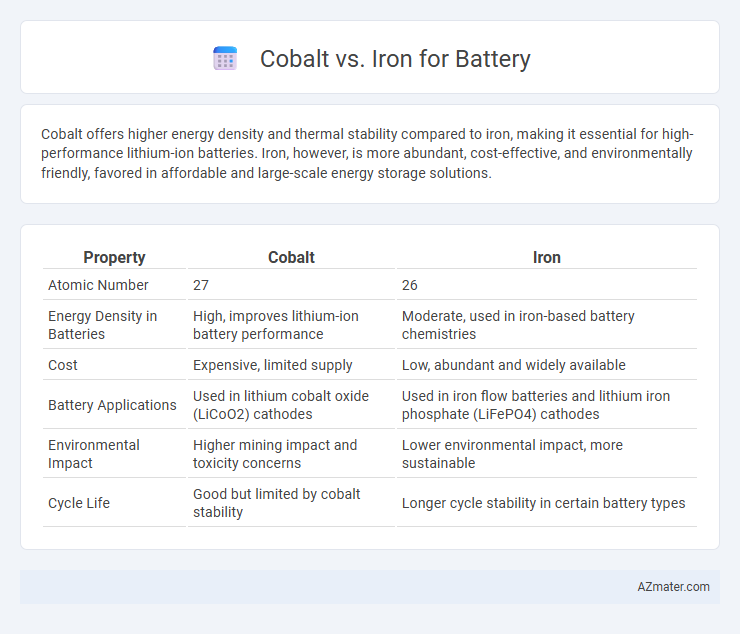Cobalt offers higher energy density and thermal stability compared to iron, making it essential for high-performance lithium-ion batteries. Iron, however, is more abundant, cost-effective, and environmentally friendly, favored in affordable and large-scale energy storage solutions.
Table of Comparison
| Property | Cobalt | Iron |
|---|---|---|
| Atomic Number | 27 | 26 |
| Energy Density in Batteries | High, improves lithium-ion battery performance | Moderate, used in iron-based battery chemistries |
| Cost | Expensive, limited supply | Low, abundant and widely available |
| Battery Applications | Used in lithium cobalt oxide (LiCoO2) cathodes | Used in iron flow batteries and lithium iron phosphate (LiFePO4) cathodes |
| Environmental Impact | Higher mining impact and toxicity concerns | Lower environmental impact, more sustainable |
| Cycle Life | Good but limited by cobalt stability | Longer cycle stability in certain battery types |
Introduction to Cobalt and Iron in Battery Technology
Cobalt and iron play crucial roles in battery technology, with cobalt being widely used in lithium-ion cathodes for its high energy density and thermal stability. Iron, particularly in lithium iron phosphate (LiFePO4) batteries, offers enhanced safety, longer cycle life, and lower cost, making it a popular alternative. The choice between cobalt and iron depends on performance requirements, cost considerations, and environmental impact in battery applications.
Chemical Properties: Cobalt vs Iron
Cobalt exhibits superior chemical stability and higher energy density, making it a preferred cathode material in lithium-ion batteries compared to iron. Iron, though abundant and cost-effective, has lower conductivity and energy capacity, limiting its use primarily to iron phosphate cathodes with enhanced safety but reduced voltage. The distinct oxidation states of cobalt (Co2+, Co3+) facilitate better electrochemical performance, while iron's variable valence states (Fe2+, Fe3+) contribute to structural stability but limit overall battery efficiency.
Role of Cobalt in Modern Batteries
Cobalt plays a critical role in modern lithium-ion batteries by enhancing energy density and improving battery stability, which directly contributes to longer battery life and safer performance. Unlike iron, cobalt's unique electrochemical properties allow for higher voltage operation and efficient charge cycles, making it indispensable in high-performance applications such as electric vehicles and portable electronics. Despite its higher cost and ethical sourcing concerns, cobalt remains essential for maintaining the optimal balance between energy capacity, durability, and safety in contemporary battery technology.
Advantages of Iron-Based Battery Materials
Iron-based battery materials offer significant advantages, including abundant availability and lower cost compared to cobalt, which makes them more sustainable and economically viable for large-scale energy storage. These materials demonstrate excellent thermal stability and safety, reducing the risk of overheating and fire hazards prevalent in cobalt-based batteries. Furthermore, iron-based batteries exhibit long cycle life and environmentally friendly characteristics, contributing to their growing appeal in renewable energy applications.
Energy Density: Cobalt vs Iron Batteries
Cobalt batteries typically offer higher energy density compared to iron-based batteries, making them more suitable for applications requiring lightweight and compact power sources. Iron batteries, such as iron-flow or iron-air variants, generally provide lower energy density but excel in cost-effectiveness and safety. The trade-off between cobalt's superior energy density and iron's abundance and stability is crucial for selecting the appropriate battery technology for specific energy storage needs.
Cost and Supply Chain Considerations
Cobalt's higher cost and supply constraints pose significant challenges for battery manufacturers compared to iron, which is abundant and more affordable. The geopolitical risks associated with cobalt mining, predominantly concentrated in the Democratic Republic of Congo, exacerbate supply chain vulnerabilities. Iron-based battery technologies, such as lithium iron phosphate (LFP), benefit from stable supply chains and lower raw material prices, making them cost-effective alternatives for large-scale energy storage solutions.
Environmental Impact and Sustainability
Cobalt mining poses significant environmental challenges due to habitat destruction and toxic waste generation, while iron offers a more abundant and less ecologically damaging alternative for battery production. The recycling rates for iron-based batteries are generally higher, promoting sustainability through reduced resource extraction and lower carbon emissions. Transitioning from cobalt to iron in battery technology supports a circular economy and mitigates social concerns linked to cobalt mining in conflict regions.
Safety and Stability Comparison
Cobalt-based batteries offer high energy density but pose safety risks due to thermal runaway and toxicity under abuse conditions. Iron-based batteries, such as lithium iron phosphate (LiFePO4), provide superior thermal stability and lower risk of combustion, enhancing overall safety and longevity. The inherent chemical stability of iron cathodes reduces degradation rates, making iron batteries a safer choice for applications requiring robust, long-lasting performance.
Future Trends: Next-Generation Battery Materials
Next-generation battery materials focus on reducing cobalt dependency due to ethical and supply chain concerns, driving research toward iron-based alternatives like lithium iron phosphate (LFP) with enhanced safety and cost benefits. Innovations in iron-rich battery chemistries aim to improve energy density and cycle life, positioning iron as a competitive option against traditional cobalt-based lithium-ion batteries. Advances in solid-state and hybrid battery technologies further support iron's potential to meet future energy storage demands with sustainable and abundant resources.
Conclusion: Cobalt or Iron for the Future of Batteries
Cobalt offers high energy density and stability but faces supply constraints and ethical concerns, making it less sustainable long-term. Iron-based batteries, particularly iron flow and iron phosphate variants, provide cost-effective, abundant, and environmentally friendly alternatives with improving performance metrics. The future of battery technology favors iron due to its scalability and eco-friendliness, while cobalt may remain critical for specialized high-performance needs.

Infographic: Cobalt vs Iron for Battery
 azmater.com
azmater.com